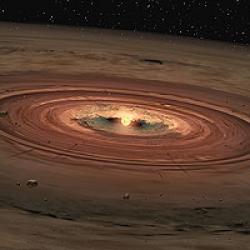Written by Nicholos Wethington
 Organic molecules are thought by scientists to be instrumental in kickstarting life as we know it on Earth. Within our Solar System they can be found in comets, and they cause the redness of the clouds of Saturn's moon Titan. New observations of a planet-forming disk around a star 220 light-years from Earth reveal for the first time that these molecules exist elsewhere in the Universe.
Organic molecules are thought by scientists to be instrumental in kickstarting life as we know it on Earth. Within our Solar System they can be found in comets, and they cause the redness of the clouds of Saturn's moon Titan. New observations of a planet-forming disk around a star 220 light-years from Earth reveal for the first time that these molecules exist elsewhere in the Universe.
Astronomers at the Carnegie Institute have detected the presence of organic molecules in the dusty disk surrounding HR 4796A, an eight-million year-old star in the constellation Centaurus. Using Hubble's Near-Infrared Multi-Object Spectrometer they analyzed the light coming from the disk and found that its red color is due to large organic carbon molecules called tholins. The analysis ruled out other causes of the red light, such as iron oxide.
“Until recently it’s been hard to know what makes up the dust in a disk from scattered light, so to find tholins this way represents a great leap in our understanding,” said John Debes of the Carnegie Institute's Department of Terrestrial Magnetism, one of the authors of the study.
Just as in our early Solar System, the disk of dust is in the process of forming planets. The collision of small bodies like asteroids and comets creates the dust in the disk, and the organic molecules present on these objects could then be scattered on any planets orbiting the star. This discovery makes it clear that it is possible for organic molecules to exist in the early stages of planet formation, paving the way for the possible development of life later on.
Organic molecules are thought to be essential to the development biological organisms because they are made up of carbon, the building block of life on Earth. The discovery of these molecules elsewhere in the Universe does not mean that life exists there yet – or even that it will in the future – but it does increase the tantalizing prospect of life forming outside our Solar System.
The study was published in the current Astrophysical Journal Letters by John Debes and Alycia Weinberger of the Carnegie Institution’s Department of Terrestrial Magnetism with Glenn Schneider of the University of Arizona.
Source: Carnegie Institute Press Release



No comments:
Post a Comment